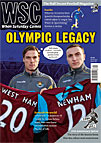 The traditional big clubs of Ligue 1 are being challenged by an astutely assembled teams of upstarts. James Eastham explains
The traditional big clubs of Ligue 1 are being challenged by an astutely assembled teams of upstarts. James Eastham explains
The only way you can tell it’s matchday in Lille is by looking at the buses. If there’s a game on, the slogan “Allez Le LOSC” runs where the name of the destination normally is (LOSC being the acronym for Lille Olympique Sporting Club). But wander into any of the city centre bars showing football and you’re likely to find the majority of the locals sampling the beers the region is famous for barely glance up at the screens.
The traditional footballing powerbase in these parts is Lens, 25 miles away to the south-west. Home crowds there occasionally exceed the town’s population and the team’s sang et or (blood and gold) colours are famous throughout the country.
On the pitch, though, there has been a distinct shift in this corner of north-eastern France in recent years. After finishing in some respectable positions during the past decade, including the runners-up spot in 2004-05, Lille are having a genuine crack at winning the French league title for the first time in living memory. Long term, the plan is to emulate the club’s heyday – they won two league titles and five French Cups in the decade immediately after the Second World War.
Lille’s biggest concern over the next few months will be running out of steam. Going into a potentially crucial fixture against fellow title contenders Marseille on March 6, the five-point lead they held over their rivals just a few weeks before had disappeared. Having qualified for the Europa League Round of 32 and the French Cup quarter-finals, Lille will play a minimum of 54 games this season, but coach Rudi Garcia also has a small squad, so relies on the same names every week. This explains why only 18 outfield players made the starting line-up in the club’s first 25 league games, with four of them appearing just once.
Should Lille hold on, however, most neutrals would regard them as worthy champions. Set up in a fluid 4-3-3 formation, les dogues (the mastiffs) play the most entertaining football in France. As comfortable dismantling heavily manned defences in home matches as they are picking off opponents with swift, precise counter-attacks away, they are one of the few sides that play to win rather than to not lose. In a division where the average number of goals a game hovers below 2.5, Lille’s 5-2 win at Caen and 6-3 home victory over Lorient are just two of several performances that provided welcome relief from the defensive football you normally see.
Like many French clubs, a lack of funds means Lille have needed nous to build a winning side. Former France internationals Mickaël Landreau and Rio Mavuba have successfully relaunched their careers since making what many regarded to be a backwards step at the time, while left-back Franck Béria and midfielder Ludovic Obraniak arrived from second-division Metz. There can’t be many title challengers anywhere in Europe whose centre-halves were spotted playing for regional fourth division sides. Aurelien Chedjou, now a Cameroon international, came from Rouen, while Adil Rami, who has started every game for France since Laurent Blanc became manager, was playing part-time football for Fréjus when he joined Lille five years ago.
The crown jewel is Eden Hazard, coveted by some of the continent’s leading clubs. Lille have often scouted across the nearby Belgian border (Brussels is a half-hour train ride away) and Hazard appears to be their greatest find so far. At 16, he was in the first team. Now 20, he has won Ligue 1’s Young Player of the Year in each of the past two seasons. A winger with quick feet and beautiful balance, he has the potential to be Belgium’s greatest ever footballer. The thrilling football explains why certain European scouts appear to have taken up residence at Stade Métropole. Local paper La Voix du Nord recently reported the “man from Juventus” is virtually a season-ticket holder, while Liverpool’s “Director of Football Strategy” Damien Comolli pays regular visits and dispatched Roy Hodgson on a spying mission before the former Fulham boss was sacked.
As always in a division where the best sides are torn apart by foreign buyers, there are fears Lille will lose their best players the minute the season is over. Rami has already agreed to join Valencia, although Hazard, a young father, seems increasingly likely to stay for another season or two rather than accepting one of the many offers likely to come his way. President Michel Seydoux and coach Garcia hope the prospect of playing in the club’s new 50,000-seat stadium will persuade key members of the squad to follow the example of captain Rio Mavuba, who recently extended his contract until 2015. The venue will be open for 2011-12 and ought to generate a level of income that allows Lille to compete financially with Marseille and Lyon. Winning something this season might be the beginning of a glorious period in the club’s history.
From WSC 290 April 2011